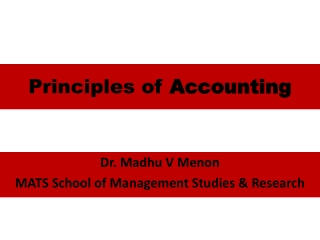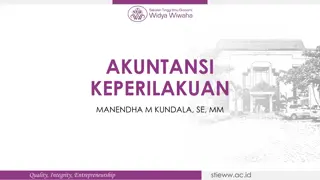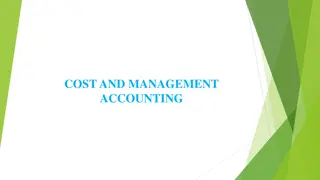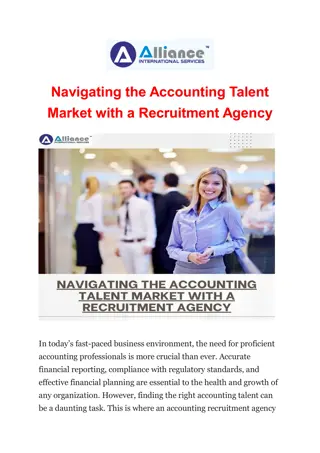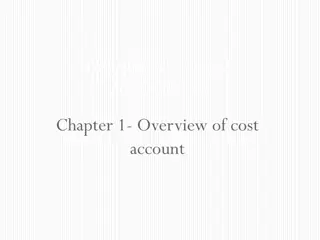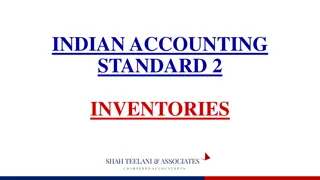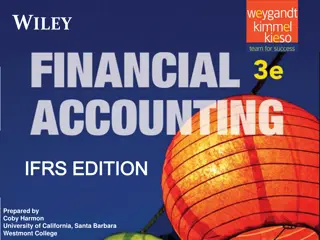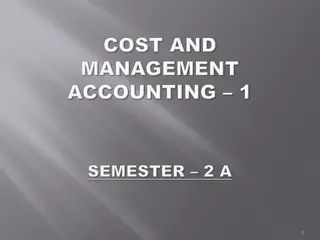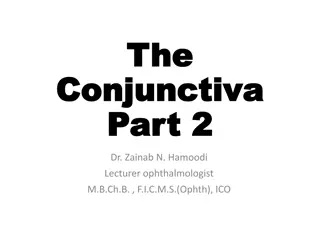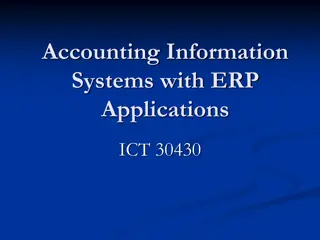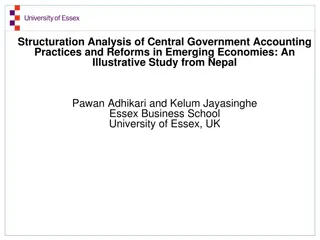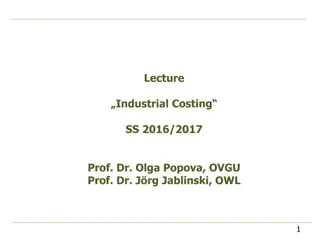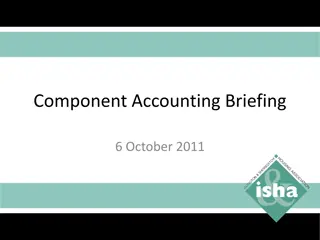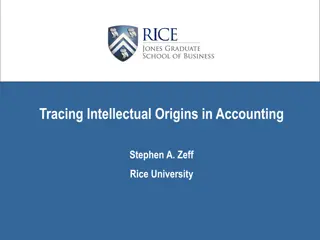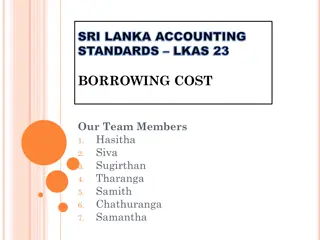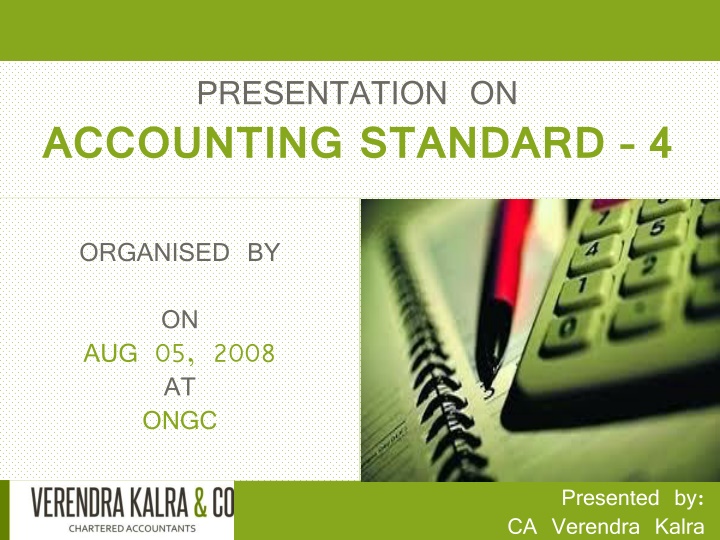
Accounting Standard 4: Contingencies & Events
Explore Accounting Standard 4 which covers contingencies and events occurring after the balance sheet date. Learn about its objective, exclusions, definitions, and accounting treatment for informed financial reporting. Presented by CA Verendra Kalra at ONGC in 2008.
Download Presentation

Please find below an Image/Link to download the presentation.
The content on the website is provided AS IS for your information and personal use only. It may not be sold, licensed, or shared on other websites without obtaining consent from the author. If you encounter any issues during the download, it is possible that the publisher has removed the file from their server.
You are allowed to download the files provided on this website for personal or commercial use, subject to the condition that they are used lawfully. All files are the property of their respective owners.
The content on the website is provided AS IS for your information and personal use only. It may not be sold, licensed, or shared on other websites without obtaining consent from the author.
E N D
Presentation Transcript
PRESENTATION ON ACCOUNTING STANDARD 4 ORGANISED BY ON AUG 05, 2008 AT ONGC Presented by: CA Verendra Kalra
ACCOUNTING STANDARD 4 Contingencies & Events Occurring After The Balance Sheet Date 2 ACCOUNTING STANDARD 4
ACCOUNTING STANDARD 4 OVERVIEW INTRODUCTION ILLUSTRATIONS OBJECTIVE AS-4 DISCLOSURES EXCLUSIONS IMPORTANT CONSIDERATIONS DEFINITIONS ACCOUNTING TREATMENT 3 ACCOUNTING STANDARD 4
ACCOUNTING STANDARD 4 INTRODUCTION The revised standard shall apply in respect of all accounting periods commencing on or after 1.4.1995 and is mandatory in nature. In respect of accounting periods commencing on a date prior to 1.4.1995, the AS as originally issued in November 1982 shall apply. 4 ACCOUNTING STANDARD 4
ACCOUNTING STANDARD 4 OBJECTIVE To prescribe the accounting of : Contingencies Events which take place after the balance sheet date (but before the approval of the balance sheet by the Board of Directors) 5 ACCOUNTING STANDARD 4
ACCOUNTING STANDARD 4 EXCLUSIONS The Accounting Standard does not apply in the following cases of contingencies due to special considerations applicable to them: Liabilities of life assurance and general insurance enterprises arising from policies issued Obligations under retirement benefit plans Commitments arising from long term lease contracts 6 ACCOUNTING STANDARD 4
ACCOUNTING STANDARD 4 EXCLUSIONS Pursuant to AS-29, Provisions, Contingent liabilties and Contingent Assets becoming mandatory, all paragraphs dealing with contigencies stand withdrawn except to the extent they deal with impairment of assets not covered by other Indian AS. For Eg: impairment of receivables ( commonly referred to as provision for bad & doubtful debts) would continue to be covered by AS-4, till AS-30, 31, & 32 become mandatory. 7 ACCOUNTING STANDARD 4
ACCOUNTING STANDARD 4 DEFINITION OF CONTINGENCY Contingency refers to: Conditions or situation (existing on the Bsheet date) The result of which is not known on the balance sheet date Result of which would be known or determined only on the happening or non happening of one or more uncertain future events Result may be either a gain or loss 8 ACCOUNTING STANDARD 4
ACCOUNTING STANDARD 4 DEFINITION OF CONTINGENCY Uncertainty is the sine qua non of contingency. Making estimates about liabilities does not by itself create the type of uncertainty which characterizes a contingency. Eg: estimating useful life of a fixed asset to calculate depreciation. Review of events occurring after the Bsheet date coupled with information available up to approval date of Bsheet are used to estimate the financial impact 9 ACCOUNTING STANDARD 4
ACCOUNTING STANDARD 4 METHODS TO BE FOLLOWED FOR ESTIMATION OF CONTINGENT LOSS Contingencies relating to Situation existing on the balance sheet date Situation not existing on the balance sheet date Contingent Loss Contingent Gain No accounting treatment is required, neither by way of provision nor by giving accounting notes Expected loss may be: Not recognised Probable Loss (Covered by Reasonably Possible Loss AS 29 now) Remote Loss 10 ACCOUNTING STANDARD 4
ACCOUNTING STANDARD 4 EVENTS OCCURING AFTER THE BALANCE SHEET DATE Classification of events Events related to circumstance existing on the balance sheet date Events not related to circumstance existing on the balance sheet date Accounting Treatment Disclosure by way of notes to accounts Loss should be accounted in the accounts & assets & liabilities to be adjusted No adjustment in accounts (non adjusting events) (adjusting events) Events occurring after the balance sheet date may indicate that the enterprise ceases to be going concern (e.g. destruction of a major production plant by a fire after the balance sheet date) may indicate a need to consider whether it is proper to use the fundamental accounting Assumption of going concern in the preparation of financial statements. 11 ACCOUNTING STANDARD 4
ACCOUNTING STANDARD 4 SOME IMPORTANT CONSIDERATIONS Even though certain events take place after Bsheet date, they are still reflected due to statutory rquirements or special considerations. For Eg: Dividends in respect of the period covered by the financial statements, which are proposed or declared after the balance sheet date but before the approval of the financial statements, should be adjusted in the accounts 12 ACCOUNTING STANDARD 4
ACCOUNTING STANDARD 4 DISCLOSURES If material contingent loss is not provided for, its nature and an estimate of financial effect should be disclosed by way of note. If estimate of financial effect cannot be made, the fact should be disclosed. Existence of guarantees, obligations arising from discounted bills of exchange etc. are generally disclosed by way of a note even though the possibility that a loss will occur is remote. 13 ACCOUNTING STANDARD 4
ACCOUNTING STANDARD 4 DISCLOSURES Events occurring after balance sheet date which do not effect figures stated in the financial statements are normally not disclosed in the financial statements. They may however be disclosed in the report of the approving authority so as to make the users of the statements aware about them. 14 ACCOUNTING STANDARD 4
ACCOUNTING STANDARD 4 ILLUSTRATION Problem 1 On 15th April, 2002, due to destruction of the factory by fire (fire took place on 27th March, 2002), one of the company s debtors, declared himself insolvent. He owed Rs. 1,17,000 to B Co. Ltd. 15 ACCOUNTING STANDARD 4
ACCOUNTING STANDARD 4 ILLUSTRATION Solution 1 Adjustments of assets and liabilities is to be made if event relates to the condition existing on the balance sheet date and provides additional evidence to assist the estimation of amounts relating to conditions existing at the balance sheet date. In this case the fire took place on 27th March, 2002 before the date of balance sheet and debtors are declared insolvent on 15th April, 2002, the event of 15th April, 2002 only provides the additional evidence to estimate the amount of loss. Accordingly, adequate provision for bad debts should be created to cover the loss arising out of insolvency for the year ended 31st March, 2002. ACCOUNTING STANDARD 4 16
ACCOUNTING STANDARD 4 ILLUSTRATION Problem 2 A client sued the company for damage against the company s failure to fulfill warranty. No provision was made as on the balance sheet as on that it was believed no liability will arise. After the balance sheet date but before the date of authorization of financial statements the court decided against the company. Solution 2 Provide for the liability. It is an adjusting event. 17 ACCOUNTING STANDARD 4
ACCOUNTING STANDARD 4 ILLUSTRATION Problem 3 A particular item of inventories is valued at cost on the basis of estimation that net realizable value is higher as on the balance sheet date as there was no sale of that item during last two months. However, sales subsequent to the balance sheet date reveals net realizable value of that particular item was less than cost. Solution 3 Value of the inventories should be written down to net realizable value. 18 ACCOUNTING STANDARD 4
ACCOUNTING STANDARD 4 ILLUSTRATION Problem 4 The company follows calendar year as the accounting period. It values investments with reference to market price prevalent as on the balance sheet date. Market price is taken from the stock exchange wherein the particular financial instrument is more frequently traded and turnover is highest on an average. There is a decline in the market price of that stock after 31.12.2001 and such decline continued on 15.2.2002, the date on which the financial statements are authorized. 19 ACCOUNTING STANDARD 4
ACCOUNTING STANDARD 4 ILLUSTRATION Solution 4 It is a non adjusting event. Subsequent decline in the market price of investments does not reflect the conditions prevailing as on the balance sheet date. It does not revise the financial statements to incorporate this change. However, there may be a need for disclosure in case disclosure will affect the ability of the user to evaluate the financial statements properly. 20 ACCOUNTING STANDARD 4
ACCOUNTING STANDARD 4 RELEVANCE TO ONGC The following disclosure was made in the last year s audited financial statements as per point 23 of Schedule 27 and point 7 of Schedule 28. Provisions involving substantial degree of estimation in measurement are recognized when there is a present obligation as a result of past events and it is probable that there will be an outflow of resources. Contingent assets are neither recognized nor disclosed in the financial statements. Contingent liabilities, if material, are disclosed by way of notes. 21 ACCOUNTING STANDARD 4
ACCOUNTING STANDARD 4 RELEVANCE TO ONGC Contingent Liabilities o Bank guarantees given by the Company: Rs. 4,834.70 million including Rs. 3,803.70 million for NELP Blocks where the company has 100% participating interest. In respect of joint ventures Rs. 573.20 million. 22 ACCOUNTING STANDARD 4
ACCOUNTING STANDARD 4 RELEVANCE TO ONGC Corporate guarantees o Executed by the Company on the behalf of MRPL: Amount of guarantee Rs. 13,475.70 million o Executed by the Company on the behalf of OVL & ONGBV: Amount of guarantee Rs. 33,353.41 million 23 ACCOUNTING STANDARD 4
ACCOUNTING STANDARD 4 RELEVANCE Claims against the Company / disputed tax demands not acknowledged as debts. In the opinion of the company, the following claims / demands are not tenable and are at various stages of appeal. o In respect of Company: Income tax matters million Rs. 18,363.94 Excise duty matters Rs. 2,939.30 million Custom duty matters Rs. 1,437.47 million Royalty Rs. 360.39 million 24 ACCOUNTING STANDARD 4 o
ACCOUNTING STANDARD 4 RELEVANCE o In respect of Joint Ventures: Income tax matters Rs. 8.91 million Custom duty matters Rs. 5,027.82 million Royalty Rs. 240.04 million 25 ACCOUNTING STANDARD 4
ACCOUNTING STANDARD 4 Thank You 26 ACCOUNTING STANDARD 4

